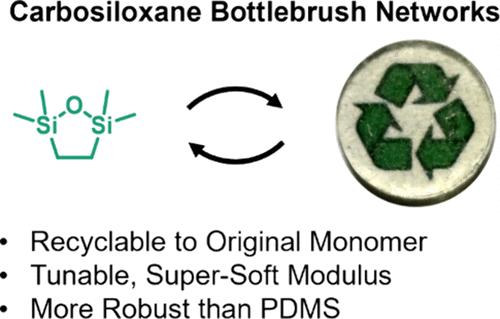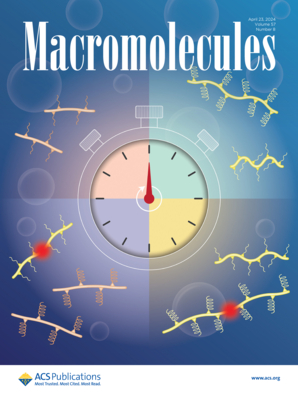Carbosiloxane Bottlebrush Networks for Enhanced Performance and Recyclability
IF 5.1
1区 化学
Q1 POLYMER SCIENCE
引用次数: 0
Abstract
Silicone bottlebrush copolymers and networks derived from cyclic carbosiloxanes are reported and shown to have enhanced properties and recyclability compared with traditional dimethylsiloxane-based materials. The preparation of these materials is enabled by the synthesis of well-defined heterotelechelic macromonomers with Si–H and norbornene chain ends via anionic ring-opening polymerization of the hybrid carbosiloxane monomer 2,2,5,5-tetramethyl-2,5-disila-1-oxacyclopentane. These novel heterotelechelic α-Si–H/ω-norbornene macromonomers undergo efficient ring-opening metathesis copolymerization to yield functional bottlebrush polymers with accurate control over molecular weight and functional-group density. Si–H groups retained at the ends of side-chains after ring-opening metathesis copolymerization allow for the preparation of supersoft networks via hydrosilylation with cross-linkers such as tetrakis[dimethyl(vinyl)silyl]orthosilicate. In contrast to traditional PDMS systems, the incorporation of poly(carbosiloxane) side chains allows the resulting networks to be recycled back to the original monomer (>85% recovery) via depolymerization at elevated temperatures (250 °C) in the presence of base catalysts (potassium hydroxide and tetramethylammonium hydroxide). The recovered monomer was successfully repolymerized through anionic ring-opening polymerization with no decrease in structural fidelity or activity. In summary, this combination of unique (macro)monomer design and bottlebrush architecture creates new opportunities in sustainable practices by offering a robust, recyclable alternative to commercial silicone-based materials.

增强性能和可回收性的碳硅氧烷瓶刷网络
报告显示,与传统的二甲基硅氧烷基材料相比,环状碳硅氧烷衍生的有机硅底层共聚物和网络具有更强的性能和可回收性。通过阴离子开环聚合杂化碳硅氧烷单体 2,2,5,5-四甲基-2,5-二ila-1-氧代环戊烷,合成出具有 Si-H 和降冰片烯链端、定义明确的杂化螯合大单体,从而制备出这些材料。这些新型杂环α-Si-H/ω-降冰片烯大单体经过高效的开环偏聚共聚作用,生成了可精确控制分子量和官能团密度的功能性瓶丛聚合物。开环偏聚共聚后,保留在侧链末端的 Si-H 基团可通过与交联剂(如四[二甲基(乙烯基)硅烷基]原硅酸盐)进行水硅烷化来制备超软网络。与传统的 PDMS 系统不同的是,加入聚(碳硅氧烷)侧链后,在碱催化剂(氢氧化钾和四甲基氢氧化铵)的作用下,通过在高温(250 °C)下解聚,生成的网络可回收为原始单体(回收率达 85%)。回收的单体通过阴离子开环聚合反应成功地进行了再聚合,其结构保真度和活性没有降低。总之,这种独特的(大)单体设计与瓶丛结构的结合,为可持续发展实践创造了新的机遇,提供了一种坚固耐用、可回收的商用硅基材料替代品。
本文章由计算机程序翻译,如有差异,请以英文原文为准。
求助全文
约1分钟内获得全文
求助全文
来源期刊

Macromolecules
工程技术-高分子科学
CiteScore
9.30
自引率
16.40%
发文量
942
审稿时长
2 months
期刊介绍:
Macromolecules publishes original, fundamental, and impactful research on all aspects of polymer science. Topics of interest include synthesis (e.g., controlled polymerizations, polymerization catalysis, post polymerization modification, new monomer structures and polymer architectures, and polymerization mechanisms/kinetics analysis); phase behavior, thermodynamics, dynamic, and ordering/disordering phenomena (e.g., self-assembly, gelation, crystallization, solution/melt/solid-state characteristics); structure and properties (e.g., mechanical and rheological properties, surface/interfacial characteristics, electronic and transport properties); new state of the art characterization (e.g., spectroscopy, scattering, microscopy, rheology), simulation (e.g., Monte Carlo, molecular dynamics, multi-scale/coarse-grained modeling), and theoretical methods. Renewable/sustainable polymers, polymer networks, responsive polymers, electro-, magneto- and opto-active macromolecules, inorganic polymers, charge-transporting polymers (ion-containing, semiconducting, and conducting), nanostructured polymers, and polymer composites are also of interest. Typical papers published in Macromolecules showcase important and innovative concepts, experimental methods/observations, and theoretical/computational approaches that demonstrate a fundamental advance in the understanding of polymers.
 求助内容:
求助内容: 应助结果提醒方式:
应助结果提醒方式:


